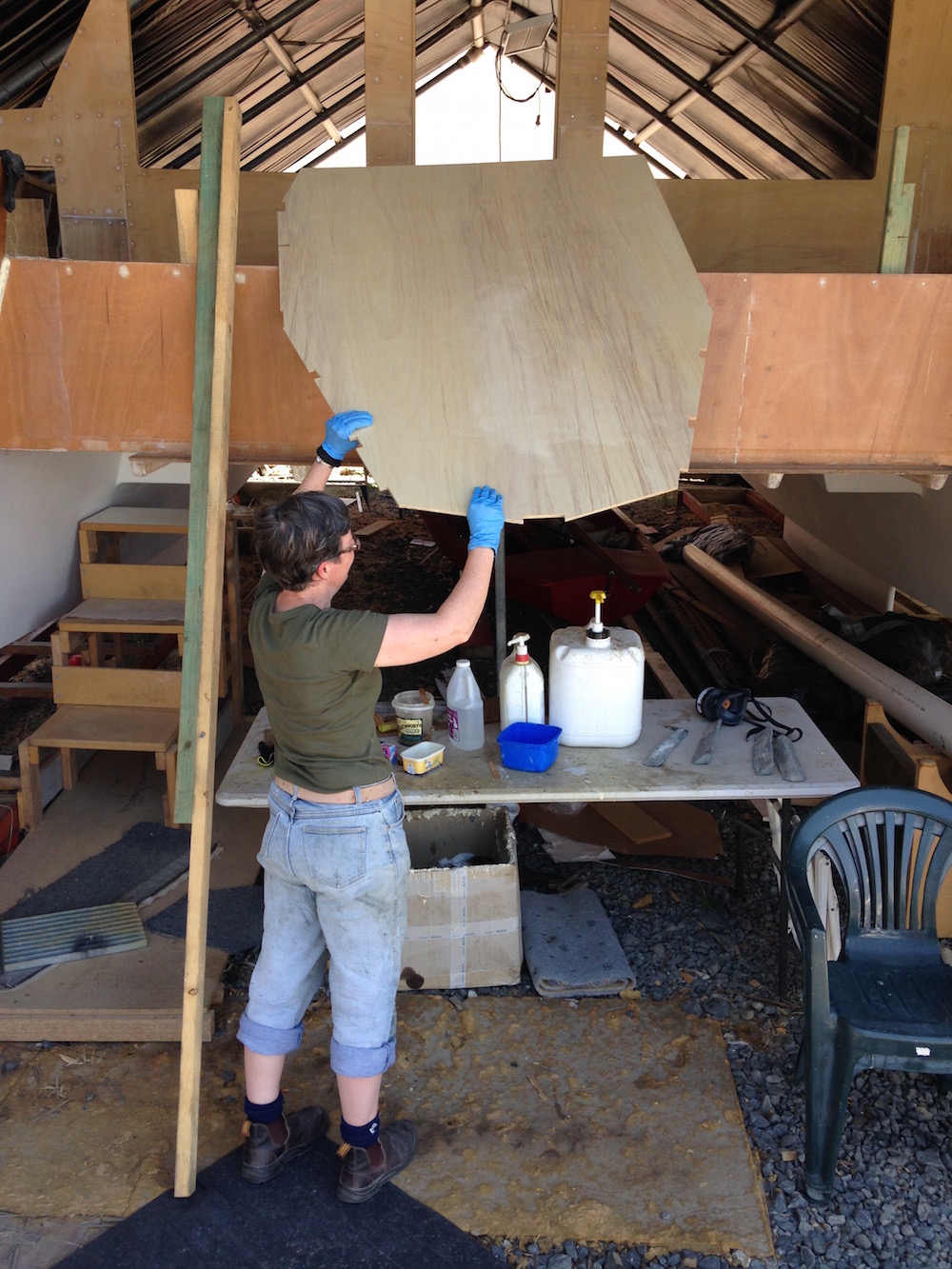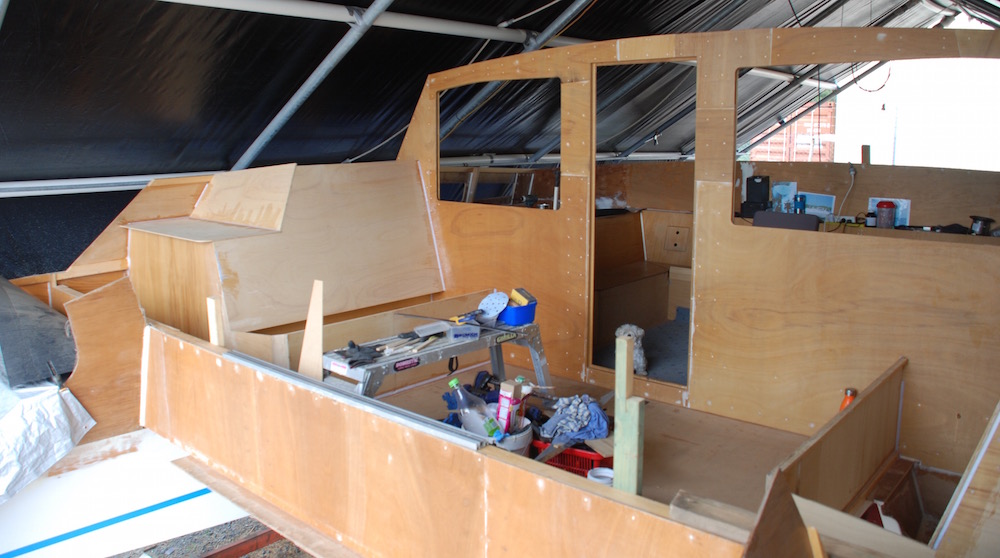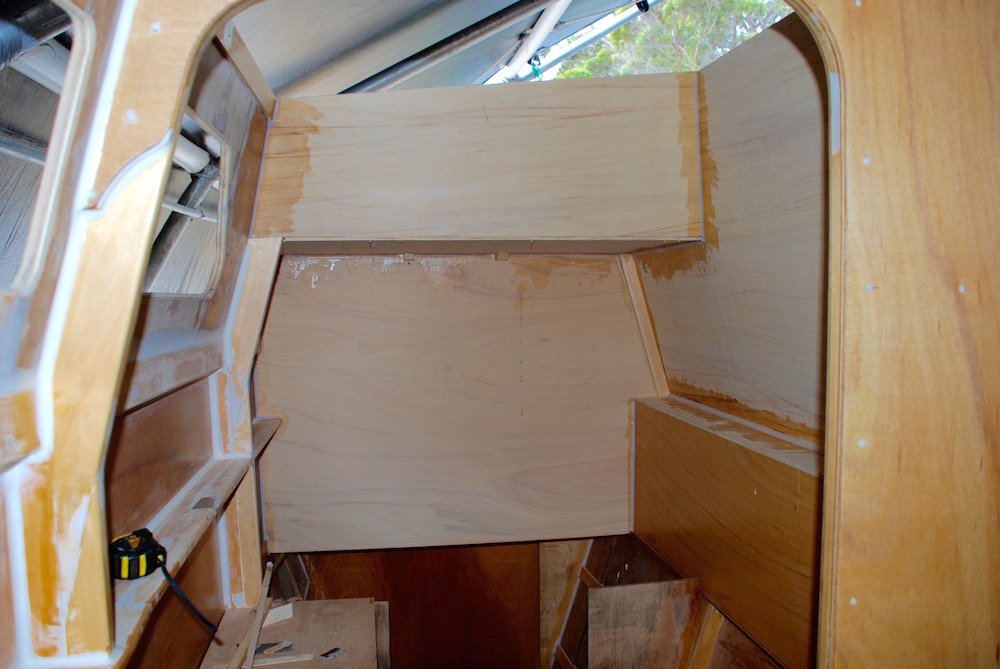Its been a busy few weeks since we have last posted. In between pushing on with the build we made a trip to Hobart for a funeral and family catch-up, returning via the east coast for a few days off.
We were pleased to finally finish frame seven. Actually, we were surprised by how long it took to complete. At first glance it looked deceptively straightforward, but, with two skins and four openings, all requiring rebates, edging and radiused corners it turned out to be a fairly technical assembly.
Once done we were free to move aft to begin work on the cockpit area.

We began by installing two sub bulkheads that define the aft end of accommodations in each hull. In the port hull, this bulkhead is the back wall of the bathroom. We made it full length, in order to completely isolate the bathroom from the space behind, where the holding tank will go. Hopefully, this will help to control odors that sometimes emanate from holding tanks.


In the starboard, galley side we made it a half bulkhead to keep it as open as possible. The compressor and heat exchanger from our refrigerator will protrude into this space. We are planning to duct air from an overhead Dorade vent into here to remove heat and help the fridge run as efficiently as possible.



As with many things on a boat, the fabrications in the cockpit area have a number of functions. They incorporate access to the outboard motors, storage for fuel tanks, storage for the hot water system, folding bikes, auxiliary generator, and steering station as well as ducting for electrical cables, steering, and engine controls. In addition, they provide shelter and seating accommodations for us humans and access up to the forward decks.

On a wild and rainy weekend that brought flooding and damaging winds to Victoria, we borrowed Robs camper and cruised up the Tassy east coast. We especialy loved the Bay of Fires, and managed to coax the camper into a spot right on the beach. It was fantastic going to sleep to the sound of 2 metre waves breaking onto the shore, just metres from our spot.

We took advantage of a special at Kogans and picked up two folding bikes. These will be our principal land transport once we move aboard, and sell the car. It will be the first time in nearly forty years we will be car-less.


Great to see your progress! Folding bikes – we haven’t got the storage space for them and have to hoof it everywhere, but it keeps us fit! Isn’t the Bay of Fires beautiful!
LikeLiked by 1 person
Yep: We have managed to incorporate a dedicated locker for the bikes in the stern steps area. An idea pinched from Chris Firth from SeeBeeZee. Bay of Fires spectacular even in the appalling weather. You can see the aqua colour of the water in the photo despite the big swells.
LikeLiked by 1 person
Ahoy Pete and Deb,
So nice to see your progress. It’s getting close no here in the Pacific North West USA. I’m at the glassing stage but looks like I’ll be waiting for a while as it’s raining here.
Do you have any drawings of the saloon you are building differently.
I am contemplating building composite chainplates. Any thoughts??
Cheers Dean
LikeLike
Hi Dean. You are like us: very subject to the weather, we feel your pain! We actually built the saloon to the principal dimensions listed in the plans. but we devised our own framing as they are not included. The main thing to consider however is the potential weight that such a large seating area may have to accommodate. The airline industry deems the average adult weight to be around 80 kg per person so for (say) 12 people that’s potentially around 960 kg. (2116 lbs). I’ll send you some photos showing how we did it: but I reckon there is more than one way to skin that cat. In relation to composite chain plates, I have no knowledge of that engineering. Pete’s plans are simple and fool-proof and have no known failures that I’m aware of. To deviate from them usually adds time, money or weight. For us time is a cost. Personally I struggle to see the advantages other than they may look better than bolt-on’s. We intend to polish the SS chain plates to add some bling. We have received our first quote of $560AUD for all 9 (including the fore-beam tangs) which works out to $62 each. I’m happy with that as they will be rounded and beveled professionally.
LikeLiked by 1 person
Dang autocorrect I meant cold. It’s getting cold here haha.
LikeLike
I added a pic of the composite chainplates on my thread on Diyyachts. They are an incorporated part of the boat. I believe they look much better and weight considerably less and there are no holes on my boat. Just a thought.
LikeLiked by 1 person